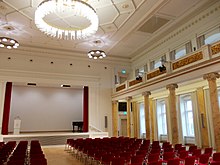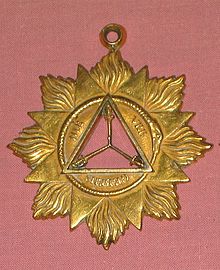Lodge hall hall

The Logenhaus Halle is a building erected in the 1820s and renovated several times at Moritzburgring 10 in Halle (Saale) . For more than 100 years it served as the lodge of the Masonic lodge " To the three swords ". After the end of the Second World War , the city headquarters of the Americans and then the Soviet military administration used the building for a short time . From 1952 to 2001, was University of Halle users of after Russian journalist Nikolay Chernyshevsky as Chernyshevsky house building designated. After a phase of vacancy and decay, the building was renovated by the end of 2011 and has been used as the headquarters of the German Academy of Natural Scientists Leopoldina since 2012 . Due to the white paint, it is sometimes referred to as the White House in Halle's vernacular .
Location
At the location of the building, the Jägerberg, there were previously gardens of the Neuwerk monastery, which was closed in 1531 . Cardinal Albrecht von Brandenburg had a hill raised on the area between 1534 and 1537 to protect the northern area of his Moritzburg (Halle) . This part was separated from the castle by a wide and deep moat and connected to it by a bridge. The hill lost its importance when the castle burned after it was conquered by the Swedes in the Thirty Years' War . The property deteriorated until the ruling administrator, Duke August von Sachsen-Weißenfels, created a park with a hunting lodge and a dog kennel. The name "Jägerberg" goes back to this time. After the Duke's death in 1680, the park became overgrown; the buildings were leased to French immigrants. From 1687 to 1705 the Huguenot and preacher Jean Vinielle lived in the hunting lodge. The first service of the Reformed church took place here. The remaining houses were rented by the government to French manufacturers for the production of woolen goods. From 1712 to 1722, the Huguenot Abel Arbalétier is said to have run a large textile manufacture with up to 30 looms, then his son-in-law Guillaume Bringuier until 1751. This added a larger outbuilding made of stones from the Moritzburg. Most recently the property was leased to Andreas Jansen from Leipzig until 1777. The court preacher Marie Ursinus received it from his inheritance. Eventually it was bought by Colonel Sergeant Johann Jeremias von Renouard in 1789 .
Building
At the suggestion of the physician and lodge member Johann Christian Reil , the Masonic lodge "To the three swords" acquired the area on March 3, 1792 for 4,300 thalers . First, the three buildings on the property were converted for their purposes. The inauguration of the lodge house took place on December 7, 1792. The increase in members of the lodge and the United Mountain Society, founded in 1800, as well as the increasing need for repairs to the buildings finally made a new building necessary around 1820. From 1821 to 1824, a new lodge building was erected on parts of the previous development according to plans by city architect Johann Justus Peter Schulze . After major renovations in 1868 and 1888, a historical lodge palace developed from this . The western half of the building, erected in 1868, is late Classicist and was built according to the plans of city building officer Karl Driesemann . The east wing, built in 1888 (architects Reinhold Knoch and Friedrich Kallmeyer) is externally in the neo-renaissance style (based on the models of the Italian renaissance ). This created a building with two stylistically different wings.
Usage history
For over 100 years the lodge used the house for its lodge activities as well as for parties, concerts and balls for its mountain society, until it dissolved itself in 1934 due to the increasing hostility from the National Socialists. It was possible to save the lodge property by transferring it to the mountain society for cultural use. This cultural society also finally disbanded on February 7, 1936 due to increasing hostility and attacks on the former lodge house. The property on the Jägerberg was donated to the city of Halle on January 29, 1937 with the condition that it could be used for further cultural purposes. The building was named "Haus an der Moritzburg". In 1938 the entire west wing of the building and part of the lower ground floor in the east wing were rented to an innkeeper who ran a restaurant along with concert and dance coffee. On the upper floor of the east wing, some rooms were converted into representative rooms for the city of Halle by 1940.
After the Second World War , the building housed the headquarters of the 104th US Division for a short time and then the city command of the Red Army , which then used it primarily as a cultural center. In this post-war period further renovations took place.
In 1952 the university took over the building as a library and lecture hall building. During this time it was named after the Russian revolutionary Nikolai Gavrilowitsch Chernyshevsky .
In 1998 it was transferred to the non-profit Weltkugel Foundation , which rented it to the University of Halle until 2001. After that, the lodge house remained unused and began to deteriorate.
In 2009 it was transferred to the German Academy of Sciences Leopoldina . The symbolic laying of the foundation stone - the building was already in place - took place on November 9, 2010, with a time capsule embedded in the ground in the former dining room on the ground floor . The topping-out ceremony was celebrated on May 18, 2011. The key handover took place on December 13, 2011. The inauguration ceremony on May 25, 2012 concluded the extensive renovation and restoration .
Several of the professors among the former members of the lodge, such as the doctors Johann Christian Reil , Peter Krukenberg , Karl Grouven and Hermann Schwartze , the mineralogists Ernst Friedrich Germar and Heinrich Girard, and the doctor and veterinarian Rudolf Disselhorst also belonged to the Leopoldina. A memorial plaque reminds of the earlier Masonic use.
The lodge
The Masonic Lodge " To the Three Swords " was founded in 1765. Her jewel contained three inwardly directed swords arranged in a star shape in a triangle, which was surrounded by an ouroboros , in which the motto of the lodge was "never in vain". Outside was an eight-pointed flamed star. The lodge belonged to the Great National Mother Lodge “To the Three Worlds” in Berlin and at times had over 500 members. Its total of 2275 full members included a .:
- Friedrich August Eckstein , classical philologist and rector of the Thomas School in Leipzig
- Johann Reinhold Forster , natural scientist and explorer
- Gustav Friedrich Hertzberg , author, ancient and regional historian
- Gabriel Wilhelm Keferstein , Councilor and Mayor of the City of Halle
- Count Christian Friedrich zu Stolberg-Wernigerode
- Friedrich August Wolf , classical philologist and classical scholar
literature
- Holger Brülls, Thomas Dietsch: Architectural Guide Halle on the Saale. Dietrich Reimer Verlag, Berlin 2000, ISBN 3496012021 .
- Michael Pantenius: City Guide Halle. Gondrom Verlag, Bindlach 1995.
- Friedrich August Eckstein: History of the Freemason Lodge in the Orient of Halle, a festive gift for the secular celebration of the Lodge on the three swords. Hall a. P. 1844.
- Carl Hugo Freiherr vom Hagen: The city of Halle, according to official sources historically-topographically-statistically represented. At the same time supplement and continuation of Dreyhaupt's Chronicle. Hall 1867.
- Gustav Friedrich Hertzberg: History of the Masonic Lodge "To the three swords" in the Orient of Halle, commemorative publication for the 150th anniversary of the Lodge. Hall a. P. 1893
- Gustav Friedrich Hertzberg: History of the Masonic Lodge to the three swords in the Orient from Halle 1843 - 1893 , Halle a. P. 1893
- Gerhard Richwien: Lodge building in Halle / S. - History, architecture and symbolism , Hamburg 2001, ISBN 3-8300-0451-6
- Guntram Seidler: The history of Halle's Johannisloge zu den Drei Degen , Halle (S.) 2009 self-published
- Files of the Halle / S.´ city archive: A 24.8. Chapter IV, Section A. No. 2, Vol. 10 Haus an der Moritzburg
- Maze of history. In: Mitteldeutsche Zeitung of September 22, 2009.
- Tscherny House is being renovated. In: Mitteldeutsche Zeitung of May 20, 2009.
Individual evidence
- ↑ "State Secretary Marco Tullner took up the name" White House ", which the residents of Halle gave the renovated building based on its facade color." (Online) November 13, 2011. URL: Leopoldina.org (accessed: August 18, 2015).
Web links
Coordinates: 51 ° 29 ′ 14.8 " N , 11 ° 57 ′ 48.5" E





